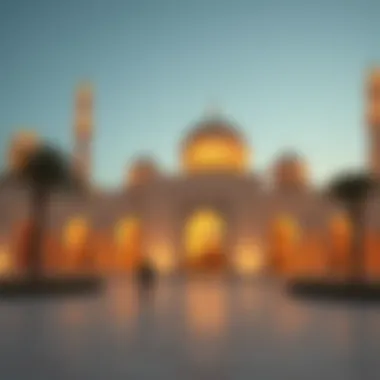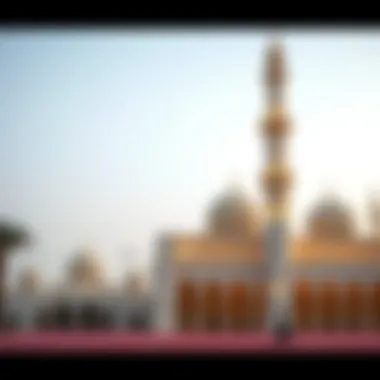The Role of Athan in Dubai's Cultural Identity


Intro
The Athan, or call to prayer, holds a pivotal role in the rhythm of life in Dubai, acting as a bridge between the historical roots of the city and its modern cosmopolitan identity. This auditory marker of time and spirituality resonates deeply within the hearts of the locals while echoing across the high rises and bustling streets of this vibrant metropolis.
As we delve into the significance of the Athan, we will explore not just its historical background but also the profound impact it has on the everyday lives of residents. Beyond the soothing call to prayer, the Athan represents a cultural touchstone for community identity, binding families and neighbors through shared faith and tradition. The advancements in technology also play a part in the dissemination of this sacred sound, illustrating how tradition and modernity can coexist harmoniously.
Through this examination, we will illuminate the significance of the Athan in nurturing Dubai's unique urban tapestry, offering insights that are both enlightening and essential for understanding the broader cultural landscape of the emirate.
Market Trends
Current Market Analysis
Today, Dubai stands as a global hub of trade and tourism, with over 90% of its populace being expatriates. Amidst this diverse backdrop, the Athan serves as an audible reminder of the city's deep-rooted traditions. It signifies more than just spirituality; it represents a daily synchronizing of various cultures, fostering a sense of belonging.
- The sound of the Athan is broadcasted from over 1,000 mosques across Dubai, each contributing to the city’s soundscape.
- Innovations in sound technology have enhanced the clarity of the Athan, allowing even the faintest call to be heard amidst the din of urban life.
- The call resonates five times a day, effectively weaving Islamic practices into the fabric of everyday activities.
Future Predictions
Looking ahead, it’s clear that the Athan will continue to play a significant role in Dubai's cultural identity. With evolving technology, we might see the emergence of more sophisticated sound broadcasting systems that ensure these calls reach an even greater audience.
- Emphasis on Heritage: The government is likely to invest in promoting cultural heritage alongside modern infrastructure, keeping the Athan at the forefront of community rituals.
- Integration with Smart Cities: As Dubai progresses towards becoming a smart city, we could witness digital applications integrating the Athan into urban planning—aligning prayer times with daily schedules in a way that respects both tradition and innovation.
In the heart of the bustling metropolis, the Athan stands as a vital element, not just marking time, but shaping collective experiences and identities.
“The call to prayer is not merely about faith; it intertwines with the very rhythm of life in Dubai.”
In Dubai, the sound of the Athan embodies the spirit of the city, and understanding its significance is crucial for anyone wishing to grasp the essence of life in this remarkable locale.
Prelims to Athan
The Athan, or call to prayer, holds a prominent position in the cultural tapestry of Dubai. It is not merely a sound that echoes from the minarets of mosques; it resonates with meaning and significance that transcends its auditory essence. In a city that melds modernity with tradition, the Athan serves as a beacon, ushering the community toward reflection, faith, and togetherness. Understanding its importance is crucial for appreciating the broader cultural landscape of Dubai.
Definition and Importance
At its core, the Athan is a declaration of the call to prayer, inviting Muslims to engage in their daily rituals of worship. Traditionally recited five times a day, it is a rhythmic reminder of spiritual obligations. More than just words, the Athan encapsulates a sense of belonging and collective identity within the Muslim community.
Key attributes of the Athan include:
- Spiritual Communication: It fosters a connection to the divine, encouraging mindfulness and regular devotion among believers.
- Cultural Heritage: The melodic tones of the Athan embody the rich cultural heritage of the Islamic faith and serve as a powerful motif in heart of Dubai.
- Community Cohesion: As communities gather for prayer, the Athan acts as a cornerstone for social interactions, reinforcing communal ties.
For expatriates and residents alike, this call is a daily reminder of the city’s Islamic roots, aiding in the understanding of local customs and traditions. This multifaceted role of the Athan illustrates its significance not just as a ritualistic practice, but as an integral part of Dubai's identity.
Cultural Context in Dubai
Dubai's landscape is a fusion of the old and the new, a vibrant metropolis that attracts a diverse population. Against this backdrop, the Athan stands out as a cultural constant, symbolizing the enduring importance of faith amidst rapid urbanization.
Factors influencing the cultural significance of the Athan in Dubai include:
- Historical Roots: Grounded in centuries of Islamic tradition, the Athan draws from a rich history that predates the city's modern skyline.
- Diverse Population: As a haven for expatriates from around the globe, the Athan serves as a point of reference for individuals seeking to comprehend and integrate into the local culture. Those unfamiliar with the practice may find themselves intrigued by its beauty and purpose, often leading to deeper discussions about faith and tradition.
- Architectural Symbolism: The visual presence of mosques and minarets in the Dubai skyline further enhances the cultural footprint of the Athan. These structures are not solely places of worship but have become emblematic of the city’s identity.
Historical Background
Understanding the historical background of Athan is crucial to appreciate its deep-rooted significance in the cultural fabric of Dubai. The pronunciation of the calls to prayer is not merely an act of religious observance; it represents a multifaceted narrative that intertwines with the city's evolution and identity. Examining its origins and evolution provides valuable insights into how this practice has shaped community cohesion, urban life, and cultural exchanges in a city that juxtaposes tradition with modernity.


Origins of Athan
The Athan, or call to prayer, has origins steeped in religious custom and tradition. It dates back to the time of the Prophet Muhammad in the early 7th century. According to various Islamic sources, the call was first voiced by Bilal ibn Rabah, one of the Prophet's companions, who was chosen for his melodious voice. From its inception in Medina, Athan has been an essential part of the Islamic faith, calling believers to unite in prayer five times a day.
This practice symbolizes more than just a reminder of prayer; it underscores the sense of belonging and community. In Dubai, the cultural and linguistic diversity creates a rich tapestry wherein the Athan serves as a binding force. The call resonates throughout the city, marking the passage of time and instilling a sense of rhythm to daily life amidst the bustling activities.
Evolution Over Time
Throughout history, the Athan has evolved both in terms of its practice and its integration within the urban landscape of Dubai. Initially, the call was announced manually, voiced by a designated muezzin from the mosque's minaret, echoing over the sands of the desert. As Dubai transitioned into the modern era, the method of delivering the call saw significant changes.
- Technological Integration: The introduction of loudspeakers in the mid-20th century transformed how Athan was broadcasted, reaching larger crowds more effectively. This innovation allowed the call to prayer to reverberate through the streets, becoming a vital part of the city's daily rhythm.
- Community Influence: As Dubai's demographic landscape became more diverse with expatriates and tourists, the Athan also began to serve as an introduction to the Islamic culture for many newcomers. It not only marked the time for prayer but also acted as a means of cultural education. New residents often find themselves contemplating the meaning of the call, its significance, and the traditions it embodies.
- Civic Engagement: In modern times, the Athan represents more than just a religious observance; it invites civic engagement. Events associated with the call to prayer increasingly include community activities, fostering a sense of collective identity among residents.
The evolution of Athan in Dubai reflects a broader narrative about balancing tradition and modernization. Its continued relevance in a rapidly changing city not only honors its origins but also redefines its place in contemporary life. The call to prayer remains a familiar sound, a thread weaving through the fast-paced lifestyle of Dubai, reminding residents and visitors alike of the city's rich cultural heritage.
"The Athan serves as a melodic reminder that in the world's hustle, there is always space for reflection and community."
As we explore further, understanding these aspects of the Athan helps frame the larger picture of its role in shaping social dynamics and cultural exchanges within Dubai.
Architectural Elements of Mosques
Mosques in Dubai are not just places of worship; they are architectural marvels that reflect the city's unique blend of tradition and modernity. The significance of these structures extends far beyond their physical presence. They serve as cultural landmarks and are deeply woven into the fabric of daily life.
Design Specifics of Dubai Mosques
The design of mosques in Dubai is a tapestry of Islamic architecture, featuring distinctive elements that contribute to their beauty and functionality. Key aspects include:
- Minarets: Tall structures that house the call to prayer (Athan), they dominate the skyline and serve as beacons for worshippers. The breathtaking Burj Khalifa may capture attention, but the minarets of mosques like the Sheikh Zayed Grand Mosque remind us of the city’s rich heritage.
- Domes: These architectural features symbolize the vault of heaven and are designed to reflect sound, directing the voice of the muezzin to the surrounding area. The domes are not just ornamental; they also play a significant role in acoustics, making it easier for prayers to echo throughout the courtyard.
- Courtyards: Many mosques, such as the Jumeirah Mosque, feature open courtyards that accommodate larger gatherings. These spaces foster a sense of community and unity, allowing worshippers to come together and participate in collective prayers.
The materials used also speak volumes about the culture's respect for tradition fused with modern touches. The use of glass, marble, and intricate mosaics creates a visual feast that captivates anyone who visits.
Acoustic Features for Athan
The call to prayer, or Athan, is a significant aspect of Islamic worship, and the architectural design of mosques plays a critical role in enhancing its delivery. Key acoustic features include:
- Strategic Placement: The positioning of the minaret is key. By placing it high above ground level, the sound travels further, ensuring that it reaches even the most distant corners of the neighborhood. This careful planning makes sure that the Athan is heard clearly and resonates well throughout the area.
- Sound Amplification: Advanced materials and techniques are employed to enhance the natural acoustics of the mosque. For instance, surfaces are often designed to reflect or absorb sound strategically, creating a rich auditory experience that uplifts the spirit.
- Technological Integration: With the advent of modern technology, some mosques have integrated audio systems that amplify the voice of the muezzin. This ensures that the Athan reaches everyone, even in bustling areas where noise levels can be high. The Dubai Islamic Affairs and Charitable Activities Department has even introduced mobile applications that alert residents when it's time for prayer, blending tradition with contemporary needs.
The architectural elements of mosques in Dubai, particularly their acoustic features, not only uphold the cultural significance of the Athan but also ensure community engagement in the spiritual practices.
Through these architectural details, mosques in Dubai don’t merely serve as places of worship; they shape the city's identity, fostering community cohesion and echoing the values of inclusivity and spirituality. Investors, expatriates, and homeowners may find these structures not only integral to the local culture but also valuable landmarks that enhance property values and quality of life.
Athan in Daily Life
The Athan is not merely a call to prayer; it weaves itself into the very fabric of daily life in Dubai. For many, the familiar sounds serve as a reminder of spiritual obligations while also acting as a signal for community practices. This cultural element transcends being just a religious observance, enriching the social dynamics and daily rhythms of residents, expats, and visitors alike.
The Role of Athan in Community Gathering
Athan plays a crucial role in fostering a sense of solidarity within the community. In neighborhoods across Dubai, the echo of the call invites individuals to pause and gather, reinforcing social bonds. It's like a communal horn, rallying people not just for prayer but for fellowship. When the Athan resonates, you can often see families heading to nearby mosques, and this moment of collective pause breeds a sense of unity that’s hard to replicate in other settings.
- Social Cohesion: The melding of diverse backgrounds forms a rich tapestry of community life. The Athan, a universal sound in this context, helps stitch this tapestry together. When people from varying cultures come together for prayer, it cultivates mutual respect and understanding, breaking down barriers.
- Celebrations and Gatherings: During significant events or holidays like Eid, the Athan becomes even more prominent, calling people to larger gatherings. Streets might come alive with festivities following the prayer, highlighting the essence of communal spirit.
This naturally leads to an environment where neighbors become friends, and friendships often turn into extended family bonds, reinforcing the idea that communal worship has its benefits.
"In a city as diverse as Dubai, the Athan serves as both a call to prayer and a call to community. It’s a reminder to pause and connect, making it an indispensable part of daily life."


Athan and Personal Rituals
Individuals also develop personal relationships with the Athan throughout their daily routines. For many Muslims living in Dubai, the sound of the Athan marks moments of reflection, much akin to how a bell might signify time for afternoon tea.
- Daily Patterns: The five daily prayers guided by the Athan align perfectly with personal schedules, offering structure to the day. It's like an internal clock; when the evening Athan rings, family members adapt their activities—whether gathering for dinner or simply enjoying a moment of quiet reflection.
- Ritual Significance: The Athan serves as a spiritual checkpoint; individuals often take a breath, recenter, and prepare themselves mentally for prayer, focusing on their faith amidst busy urban life. It instills a sense of tranquility that might be otherwise lost in the city's hustle and bustle.
Engaging with the Athan is not merely about adherence to rituals but also about maintaining a personal connection to faith amidst an ever-changing landscape.
Technological Advancements in Athan Distribution
The role of technology in the dissemination of Athan in Dubai has transformed how this call to prayer is experienced and perceived. Historically transmitted through loudspeakers at mosques, the Athan's reach now extends beyond the walls of these sacred spaces, connecting a diverse population that spans multiple cultures and backgrounds. As the population in Dubai continues to flourish, the methods of broadcasting the Athan have adapted to suit the modern urban environment, thus playing a crucial part in maintaining the spiritual and cultural identity of the city.
Broadcasting Methodologies
The evolution of broadcasting methodologies has been nothing short of remarkable. Traditionally, the Athan echoed through the airwaves, carried by loudspeakers mounted on mosques. Although this method remains prevalent, the advent of digital technology has opened up new avenues for dissemination.
- Digital Broadcast Systems: Many mosques have upgraded to more sophisticated systems that not only amplify sound but also enhance clarity. This ensures that the Athan can reach farther and be heard distinctly even in a bustling urban landscape.
- FM Radio: In addition to on-site broadcasting, some stations have started to include the Athan in their daily programming. This allows individuals who may not be near a mosque to still partake in the spiritual experience of the Athan.
- Internet Streaming: Larger mosques have begun streaming the Athan live over the internet, which allows a global audience to listen in. People can join in on the call to prayer even from thousands of miles away, effectively bridging distances through technology.
The adoption of these broadcasting methodologies not only preserves the cultural essence of the Athan but also fosters a sense of community among residents and expatriates alike, regardless of their geographical location.
Mobile Applications and Athan Alerts
Smartphones have become an integral part of daily life, and their potential in enhancing the experience of Athan cannot be overlooked. Mobile applications tailored for prayer timings now serve as digital companions for many users. These applications focus on delivering timely notifications for Athan, ensuring followers never miss the moment of prayer.
- Customizable Alerts: Users can customize alerts based on their location, which addresses the unique schedule variations across different neighborhoods in Dubai.
- Islamic Features: Many apps provide additional features such as Quranic verses, prayer guides, and Islamic calendar events, enriching the user's experience beyond just notifications.
- Community Engagement: Some applications even allow community interaction, where users can share reflections on the significance of each prayer time. This contributes to a shared cultural experience amongst expats and locals alike.
"The introduction of technology in the dissemination of the Athan truly reflects our rapidly evolving society, allowing individuals to connect with their faith and each other, even in this fast-paced urban life."
From improved broadcasting technologies to mobile applications, these advancements highlight how the Athan maintains its place at the heart of Dubai's cultural identity. As technology continues to evolve, the potential for even broader outreach is on the horizon, ensuring that the spirit of the Athan endures.
Athan and Expatriate Communities
In Dubai, a city that thrives on diversity, the Athan plays a pivotal role not only as a religious call to prayer but also as a catalyst for cultural integration and understanding among the myriad expatriate communities. The unique sound of the Athan, echoing from the minarets, serves not only the locals but importantly reaches those who have made Dubai their home from far-flung corners of the globe. Understanding this significance sheds light on how this tradition fosters a sense of belonging and connection.
Inclusivity and Cultural Exchange
The call of the Athan transcends mere religious function; it acts as a bridge for cultures to meet. In a bustling hub like Dubai where countries and cultures intermingle, the Athan is an audible reminder of commonality. Expatriates often find themselves in a mix of emotions when they hear it—some may think, "This is part of my neighbor's culture, yet it is also part of my experience here."
The Athan becomes an anchor point, a signal that encourages community gatherings and events. For instance, many expatriate groups organize cultural evenings that coincide with prayer times. This integration not only fosters friendship but enhances a wider understanding of Islamic traditions. Such cultural exchanges fortify community ties and cultivate an environment where differences are celebrated rather than shunned.
"In a multicultural city like Dubai, the Athan serves as both a reminder of faith and a music for community ties, resonating within hearts and minds of many."
Understanding Athan for New Residents
For newcomers in Dubai, the Athan can be both a fascinating aspect of their new environment and a source of confusion. Many expatriates may not be familiar with the concept or significance of the Athan. To smooth this transition, several initiatives aim to educate new residents about the practice. Many mosques offer tours, and online platforms provide insights into the timing and the significance of the calls to prayer.
Knowing when to expect the call can ease the daily routine of expats, helping them integrate better into the rhythm of life here. For example, some families have noted the call during midday as a reminder to take a break, sit down for lunch, and reflect on their day so far. It becomes a gentle nudge towards mindfulness amidst the bustling life of Dubai.
Understanding the Athan, therefore, is not only about recognizing its religious significance but embracing it as an essential aspect of Dubai's social fabric, inviting newcomers into a broader conversation that encompasses respect, curiosity, and engagement with a different culture.
Thus, the Athan’s role extends beyond its initial purpose; it becomes a lens through which expatriates can view and engage with their host city, enriching their experience and enhancing the multicultural spirit of Dubai.
Challenges of Athan in Urban Environments


In a rapidly evolving city like Dubai, the Athan serves as a crucial cultural element that connects the past to the present. Yet, as urban spaces expand and diversify, it faces unique challenges that prompt us to consider how traditional practices can fit within modern frameworks. Thus, understanding these challenges is essential not only for preserving the cultural significance of the Athan but also for navigating the complexities of contemporary urban life.
Noise Regulations and Community Standards
The Athan's call to prayer can be a point of contention in urban settings where noise regulations are strictly enforced. Residents of Dubai appreciate the serenity that comes with modern living, but they also value the spiritual connection provided by the Athan. Therefore, local authorities have established noise ordinances that often restrict when and how loud public sounds can be.
During certain hours, the Athan must compete with everyday noises like traffic or construction, leading to a diminished experience. Moreover, some expatriates or non-Muslim residents might not be familiar with or may not understand the cultural significance behind it, resulting in potential misunderstandings or complaints about the volume.
“Cities are alive with sounds, and each has its own heartbeat; for Dubai, the Athan is a foundational rhythm.”
In addressing these challenges, community leaders often engage in discussions with various stakeholders to find a middle ground that respects both the Athan and noise standards, ensuring that this audible representation of faith remains a part of urban life.
Balancing Tradition and Modernity
As the skyline of Dubai continues to change, the balancing act between tradition and modernization becomes increasingly important. The Athan symbolizes a deep-rooted spiritual tradition, yet its presence must coexist in a typology of ultra-modern architecture and lifestyles. For many expats, the juxtaposition of the serenely melodic call to prayer against a backdrop of towering skyscrapers might feel surreal.
There’s an ongoing conversation about incorporating modern technology with traditional practices. For example, some mosques have turned to digitally amplified sound systems while maintaining the spiritual essence of the Athan. However, this raises questions about authenticity and whether such adaptations compromise the original experience.
Furthermore, new residents often ask how the Athan fits into the broader narrative of Dubai. They wonder how a cosmopolitan identity can embrace a traditional call to prayer without alienating those unfamiliar with it. Recognizing that the Athan is not merely an auditory experience, but a culturally rich tradition, is critical in fostering a city that values both its innovative spirit and its heritage.
In this way, Dubai can continue to be a hub for cultural exchange, where the authentic call of the Athan harmonizes with the pulse of modern urban life, connecting communities while embracing progress.
Comparative Analysis: Athan in Other Cities
Analyzing the Athan's role beyond Dubai offers fascinating insights into how different cultures and communities express their spiritual identities. In various cities, the Athan adapts to local contexts, shaping and being shaped by regional practices and beliefs. This comparative exploration underscores the significance of the Athan as not just a call to prayer, but also a cultural symbol that enriches community ties.
Variations in Practice Across the Gulf Region
In the Gulf region, where Islamic traditions are deeply ingrained into the social fabric, the practice of Athan varies significantly. For instance, in Saudi Arabia, the Athan is a resounding communal event, often played at high volumes and accompanied by a sense of urgency. The time-honored tradition sees mosques across cities like Jeddah and Riyadh using high-tech loudspeakers that can reach far distances. In contrast, cities like Muscat in Oman tend to have a gentler tone in their Athans, reflecting the local culture that values a more subdued approach to public worship.
Similarly, in Kuwait, the variation in Athan delivery can reflect the multiplicity of art forms, influenced by local dialects and even musical rhythms. This distinct approach fosters a variety of experiences that can be appreciated and adopted by expatriate communities, promoting cross-cultural understanding and connections.
- Technological Enhancements: Gulf cities have embraced modern technologies to enhance traditional practices. In Qatar, for instance, the Athan can be heard through smartphone apps and other digital platforms, ensuring that everyone, regardless of their physical location, can partake in the spiritual call.
- Cultural Significance: Each city's interpretation of the Athan plays a vital role in its identity and community cohesion. Local customs and preferences shape not just the sound but also the emotional response it evokes among residents.
Global Perspectives on Athan
When looking beyond the Gulf region, the Athan has also captured the interest of communities and scholars worldwide. In places with significant Muslim populations, such as Istanbul, Jakarta, and even cities like Paris, the Athan stands out as a beacon of cultural engagement. In Istanbul, for example, the sound of the Athan reverberates through the city's historic mosques, melding with the city's rich historical tapestry.
- Cultural Exchange: In some Western cities, the sound of the Athan symbolizes the diverse landscape of urban life. This not only fosters a greater understanding of Islamic practices among non-Muslims but also serves as a reminder of the interconnectedness of different cultures. In global communities, especially where the Islamic diaspora resides, the Athan functions as a cultural link, bonding individuals with their heritage.
- Controversy and Acceptance: While the Athan often enriches community life, it has also faced challenges in various countries. Some cities grapple with complaints about sound levels, leading to discussions about the place of traditional practices in modern urban societies. However, these dialogues frequently lead to greater awareness and acceptance among non-Muslims, emphasizing the need for respect and coexistence.
As we observe these practices and adaptations across different cities, it's clear that the Athan fosters a rich tapestry of cultural identity, transcending geographical boundaries. This global perspective on Athan not only deepens our understanding of its significance but also highlights the shared values that unite diverse populations in their spiritual journeys.
Finale and Future Implications
In this exploration of the Athan's role within Dubai’s cultural framework, it becomes evident that this powerful call to prayer transcends mere auditory experience; it weaves itself into the very fabric of daily lives in this metropolitan area. It is robustly resonant, enriching the collective conscience of a diverse population and standing as a symbol of Islamic heritage in the rapidly evolving landscape of Dubai. The Athan draws attention to the critical balancing act of acknowledging tradition while accommodating modernity and globalization.
Reflecting on Athan's Cultural Impact
The Athan has deep cultural implications, serving not only a religious function but also fostering communal ties among residents and emphasizing shared identity. As expatriate communities flourish and interlace with local populations, the Athan has the uncanny ability to serve as a bridge across cultural divides. It can be found reverberating through the stone and glass of architectural marvels like the Jumeirah Mosque, reminding everyone of their place within this metropolis.
- Identity Reinforcement: For many Muslims in Dubai, the call to prayer constitutes a reaffirmation of faith, de-cluttering the chaos of urban life. It provides structure in a world that can often feel disjointed.
- Cultural Longevity: The enduring nature of the Athan reflects a commitment to preserving one’s cultural roots even amid globalization.
- Expatriate Connections: Fresh arrivals find a sense of belonging as they familiarize themselves with this distinct cultural expression, which is both welcoming and grounding.
"The Athan not only marks time for prayers but also strengthens bonds within the community, serving as a reminder of shared values and diverse backgrounds."
Visions for Future Integration
Looking ahead, the integration of Athan within Dubai's progressive vision has the potential to evolve further. The strength lies in its capacity to adapt while retaining its essence, becoming a touchstone for future cultural discourse.
- Enhanced Technology Utilization: Innovations like smart city features could optimize how the Athan is broadcasted, ensuring clarity while adhering to noise regulations. Applications on smartphones could serve as personal reminders, helping individuals align their daily schedules with prayer times.
- Community Engagement: Through cultural initiatives or programs aiming at educating the lesser-known cultural aspects surrounding the Athan, Dubai can continue to foster a sense of unity amongst its populace.
- Symbol of Coexistence: As the city navigation towards a more inclusive future, the Athan could also serve as a symbol for mutual respect among various religious practices, sparking meaningful dialogues.
The pathway forward requires a nuanced understanding of cultural sensitivities, as well as a keen eye for innovation, in order to underscore the importance of the Athan in both a spiritual and communal sense.











